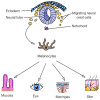Targeting Skin Neoplasms: A Review of Berberine's Anticancer Properties
- PMID: 40710294
- PMCID: PMC12293131
- DOI: 10.3390/cells14141041
Targeting Skin Neoplasms: A Review of Berberine's Anticancer Properties
Abstract
Skin cancers are associated with a significant psychological burden across all age groups, particularly as their global incidence continues to rise. Ultraviolet (UV) radiation-primarily UVA and UVB-remains the leading etiological factor, inducing DNA mutations in key genes such as TP53 and BRAF. Among skin cancers, basal cell carcinoma (BCC) is the most prevalent and typically indolent. In contrast, squamous cell carcinoma (SCC) tends to be more invasive, while melanoma is the most aggressive and prone to metastasis. Melanoma is especially concerning due to its rapid dissemination and its occurrence not only on the skin but also in ocular, mucosal, and nail tissues. These challenges, along with rising treatment resistance and mortality, underscore the urgent need for novel anticancer agents. Berberine-a plant-derived isoquinoline alkaloid-has attracted increasing attention for its broad-spectrum anticancer potential, including against skin cancers. In this review, we summarize current evidence regarding berberine's mechanisms of action in melanoma and SCC, emphasizing both its preventive and therapeutic effects. We further explore its potential as an adjuvant agent in combination with conventional treatments, offering a promising avenue for enhancing the clinical outcomes of skin cancer therapy.
Keywords: adjuvant therapy; anticancer activity; berberine; melanoma; natural compounds; skin neoplasms; squamous cell carcinoma.
Conflict of interest statement
The authors declare no conflicts of interest.
Figures










References
Publication types
MeSH terms
Substances
LinkOut - more resources
Full Text Sources
Medical
Research Materials
Miscellaneous

